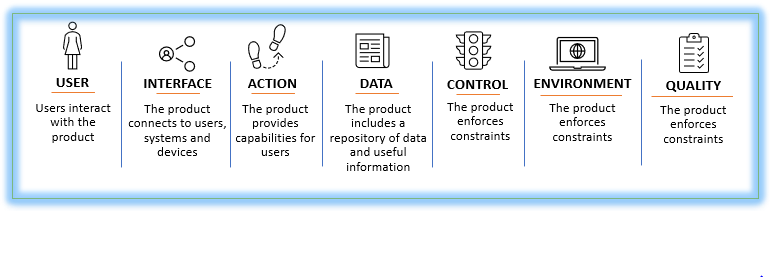In their book Discover to Deliver: Agile Product Planning and Analysis, authors Ellen Gottesdiener and Mary Gorman introduced a simple and powerful model to guide product discovery effort – The 7 Product Dimensions model. This model identifies 7 areas (product dimensions) that we will need to explore – through collaborative questioning and reflection – in order to learn more about the product. The dimensions are User (who the users are), Interface (how they interact with the product), Actions (what they can do), Data (what data the product needs/stores in order to work), Control (rules & constraints), Environment (platforms that would host the product/on which value will be delivered), and Quality Attribute (customer’s expectations around quality, usability, etc.). The premise is simple: if we ask good, powerful questions about each of these dimensions, we’ll learn a great deal about this product we want to build, which will help us build a better product. You can find more information about the 7 Product Dimensions framework and canvas Here[1]

Here are some of the questions that we could ask to discover more about each product dimension:
- User: Who are the people/systems/devices that will use/directly interface with this product?
- Interface: What will the interface look like? do we need to interface with any external databases or systems? What technical design will satisfy the user experience? What APIs do we need for the actions to communicate with business systems?
- Actions: What type of actions will users take when using this product (reflect on the capabilities identified earlier)? What are the capabilities the product offers its users? (e.g. search for subscriptions, establish an account, purchase a subscription, modify a subscription, purchase equipment, and modify an account, etc.) Does the team have the skills and knowledge to implement these actions?
- Data: The data dimension identifies the data and information the product retains. What data is needed to support those user actions? What data is most useful for the business to understand user behavior and assess the value this product has created to the customer? Where do we store, protect, and expose the data?
- Control: The control dimension identifies constraints that need to be enforced, usually in the form of policies and regulations implemented as business rules. Are there any constraints on what the users can do/what they can access on this product? what regulations or internal policies do we (the business) need to conform to for this product? How do we ensure that the product interface is secure?
- Environment: The environment dimension represents the product’s hardware and software platforms. Will the product work on smartphones, tablets, etc.? Which ones? Which software and hardware platforms will be used?
- Quality Attributes: The quality attribute dimension represents the properties that qualify the product’s development and operation. What are our customers’ expectations regarding things like speed, usability, performance, availability, etc.? can the product scale to meet peak times and still maintain a reasonable response time?
#devops #agile adoption #agile best practices #agile and devops #agile adaptation #agile application delivery #agile community
